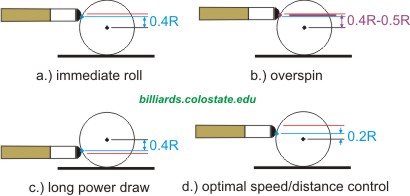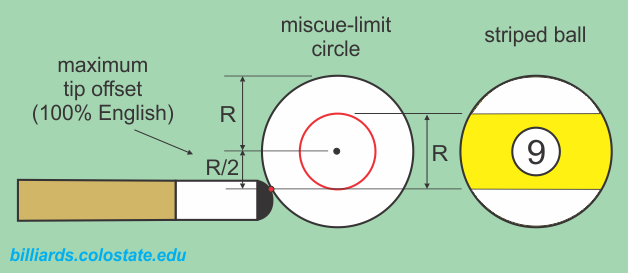How high or low should you contact the CB for different types of shots?
See the illustration below from “How High or Low Should You Hit the Cue Ball?” (BD, September, 2011). To have the CB roll immediately (e.g., for a follow shot where the OB is close to the CB), the tip contact height should be 40% of the ball radius above the center (see “a”). It is possible to create slight overspin if you can hit the CB between 40% and 50% above the center (see “b”). For long power draw shots, the optimal tip contact height is 40% below center (see “c”); although, for shorter draw shots, maximum backspin occurs with a hit 50% below center. To help achieve the best speed and distance consistency, it is best to hit the CB at about 20% above center (see “d”).

To get maximum spin (top, bottom, left or right), the tip contact point should be at the miscue limit, which is 50% from center. As shown below, the width of a standard striped ball can useful for visualizing this.

Why do some players address the CB much lower than they intend to hit?
Some players address the CB very low, with the tip on the table at the base of the CB, because they drop their elbow during the stroke into the CB, especially on power shots. This will cause the tip to rise during the stroke, so the tip must be aimed lower to compensate.
Some players address the CB low because it can make it easier to visualize the center of the CB. The resting point on the table at the base of the ball is a good visual reference for the center of the CB. Finding and aligning with the center of the CB is very important for aiming shots (see finding the center of the CB and vision center). Some people will first place the tip low and then move it to the desired position (up/down or left/right) relative to this position. Some move the tip while addressing the CB, and others don’t move it until during the final stroke.
Another possible advantage of having the tip low at address is it allows a fuller view of the CB, with the cue out of the way, which can help one visualize shot aim and alignment.
Sometimes players actually intend to hit the CB low, even when it might not seem necessary for the shot. A good examples is a drag shot.
Dr. Dave keeps this site commercial free, with no ads. If you appreciate the free resources, please consider making a one-time or monthly donation to show your support:
